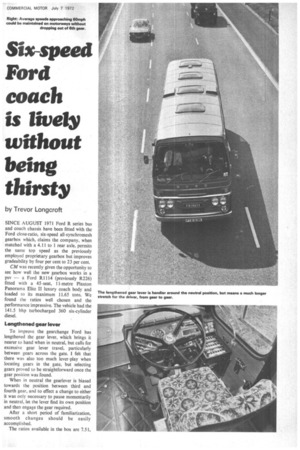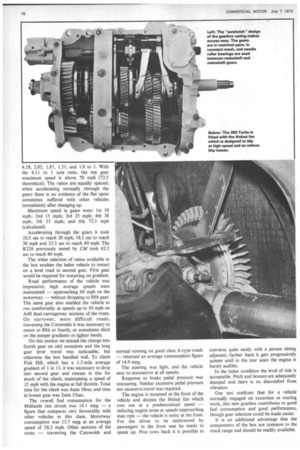Six-speed
Page 79

Page 80

If you've noticed an error in this article please click here to report it so we can fix it.
Ford coach is lively without
being
thirsty
by Trevor Longcroft SINCE AUGUST 1971 Ford R series bus and coach chassis have been fitted with the Ford close-ratio, six-speed all-synchromesh gearbox which, claims the company, when matched with a 4.11 to 1 rear axle, permits the same top speed as the previously employed proprietary gearbox but improves gradeability by four per cent to 23 per cent.
CM was recently given the opportunity to see how well the new gearbox works in a psv — a Ford R1114 (previously R226) fitted with a 45-seat, 11-metre Plaxton Panorama Elite II luxury coach body and loaded to its maximum 11.65 tons. We found the ratios well chosen and the performance impressive. The vehicle had the 141.5 bhp turbocharged 360 six-cylinder diesel.
Lengthened gear lever To improve the gearchange Ford has lengthened the gear lever, which brings it nearer to hand when in neutral, but calls for excessive gear lever travel, particularly between gears across the gate. I felt that there was also too much lever-play when locating gears in the gate, but selecting gears proved to be straightforward once the gear position was found.
When in neutral the gearlever is biased towards the position between third and fourth gear, and to effect a change to either it was only necessary to pause momentarily in neutral, let the lever find its own position and then engage the gear required.
After a short period of familiarization, smooth changes should be easily accomplished.
The ratios available in the box are 7.51, 4.58, 2.85, 1.87, 1.31, and 1.0 to I. With the 4.11 to 1 axle ratio, the top gear maximum speed is above 70 mph (72.5 theoretical). The ratios are equally spaced; when accelerating normally through the gears there is no evidence of the flat spots sometimes suffered with other vehicles immediately after changing up.
Maximum speed in gears were: 1st 10 mph; 2nd 15 mph; 3rd 25 mph; 4th 38 mph; 5th 55 mph; and 6th 72.5 mph (calculated).
Accelerating through the gears it took 10.5 sec to reach 20 mph, 18.5 sec to reach 30 mph and 33.3 sec to reach 40 mph. The R226 previously tested by CM took 42.5 sec to reach 40 mph.
The wider selection of ratios available in the box enables the laden vehicle to restart on a level road in second gear. First gear would be required for restarting on gradient. Road performance of the vehicle was impressive; high average speeds were maintained — approaching 60 mph on the motorway — without dropping to fifth gear. The same gear also enabled the vehicle to run comfortably at speeds up to 50 mph on A40 dual carriagewaysections of the route. On narrower, more difficult roads, traversing the Cotswolds it was necessary to resort to fifth or fourth, or sometimes third on the steeper gradients or tighter bends.
On this section we missed the change into fourth gear on odd occasions and the long
gear lever travel was noticeable, but otherwise the box handled well. To climb Fish Hill, which has a 1.3-mile average gradient of 1 in 13, it was necessary to drop
into second gear and remain in this for much of the climb, maintaining a speed of 15 mph with the engine at full throttle. Total time for the climb was 4min 58sec and time in lowest gear was 2min 55sec.
The overall fuel consumption for the Midlands test circuit was 14.1 mpg — a figure that compares very favourably with other vehicles in this class. Motorway consumption was 13.7 mpg at an average speed of 58.3 mph. Other sections of the route — traversing the Cotswolds and normal running on good class A-type roads — returned an average comsumption figure of 14.9 mpg.
The steering was light, and the vehicle easy to manoeuvre at all speeds. Response to brake pedal pressure was reassuring. Neither excessive pedal pressure nor excessive travel was required.
The engine is mounted at the front of the vehicle and despite the Holset fan which cuts out at a predetermined speed — reducing engine noise at speeds approaching max rpm — the vehicle is noisy at the front. For the driver to be understood by passengers in the front seat he needs to speak up. Five rows back it is possible to converse quite easily with a person sitting adjacent; farther back it gets progressively quieter until in the rear seats the engine is barely audible. In the laden condition the level of ride is acceptable. Pitch and bounce are adequately damped and there is no discomfort from vibration.
Our test confirms that for a vehicle normally engaged on excursion or touring work, this new gearbox contributes to good fuel consumption and good performance, though gear selection could be made easier.
It is an additional advantage that the components of the box are common to the truck range and should be readily available.
















































































































































